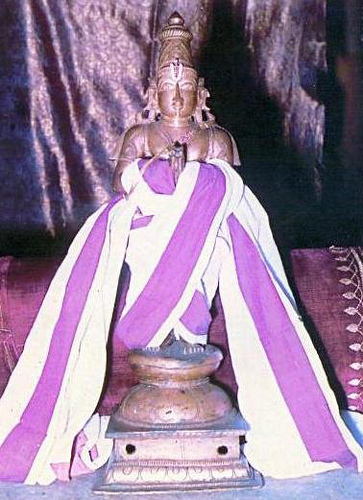This Sri Sookthi is composed by Sri Kulasekhara Azhvar
MEANING
In this final and fortieth verse of mukunda-mAlA, SrI kulaSEkharar puts the stamp of his authorship and acknowledges his friendship totwo brAhmin poets- Padman and Saran. This reference to his friends has cast doubts as to SrI KulaSEkharAzhvAr’s authorship of mukunda-mAlA. There is a school of thought which believes that Mukunda-mAlA may be the work of another king by the same name KulaSEkhara who lived many years after the AzhvAr.
Many interpretations have been given for this part of the verse: “mitrE dvijanma varapadmaSarAvabhUtAm”.
Some have interpreted it as “dvijanmavaraSca padmavaraSca” meaning there were two dear friends of King kulaSEkhara whose names were “dvijanmavara” and “padmaSara”.
Others have interpreted it as two noble brAhmaNa-s (dvijanmavara) whose names were “padman” and “Saran”.
Yet another interpretation is that King kulaSEkhara is paying tribute to nammAzhvAr and periyAzhvAr who appeared before and after kulaSEkharAzhvAr. In this interpretation, “dvijanma” refers to SrI periyAzhvAr who appeared in a brAhmaNa family. The term “padmaSara” refers to SrI nammAzhvAr since it means one with flower arrows in his hand. Since nammAzhvAr’s name is “mARan SaThakOpan”, by some stretch of imagination, one can equate the term, “padmaSaran” with SrI NammAzhvAr who preceded KulaSEkharAzhvAr.
In spite of these controversies it is generally conceded that SrI KulaSEkharAzhvAr is the true author of this splendid poem, Mukunda-mAlA replete with parama-bhakti for SrI Ranga-nAtha.
Returning to the rest of the verse, SrI KulaSEkharAzhvAr describe himself as a bee (shaTpadam) that drinks the nectar of the Lotus Feet of SrI RanganAtha and it was he, known as KulaSEkhara-rAja who composed the mukunda-mAlA.
SrI KulaSEkhara is one of the greatest proponents of nAma-siddhAnta and nAma-bhajana approach for reaching the abode of the Lord. He overcame the ills of kali-yugam by closely following the route suggested by kali- santaranOpanishad passage quoted below:
“bhagavat Adi-purushasya nArAyaNaysa nAmOccAraNa mAtrENa nirdhUtakalirbhavati”
In the doctrine of nAma-siddhAntam described in kali-santaranOpanishad, SrI nArada asks brahma, “What is that name that enables one to cross the ocean of samsAra in kali-yuga?”
Brahma replies:
“harE rAma harE rAma, rAma rAma, harE harE | harE kRshNa harE kRshNa, kRshNa kRshNa, harE harE ||”
Brahma describes that the recital of the names – RAma, Hari and kRshNa will be the effective means to overcome the ills of kali-yuga.
SrI KulaSEkhara followed the advice of catur-mukha-brahma and sang with delight the names of mukunda in his mukunda-mAlA and wondered, like the following Vishnu purANam verse, about the ignorance of human beings who do not understand the Supreme value of reciting the Lord’s names:
“mARcO mA yajustAta mA sAma paTha kincana | gOvindEti harEr-nAma gEyam gAyasva nityaSa: || nArAyaNEti SabdO’sti vAgasti vaSavartinI | tathApi narakE ghorE patantItyEtad adbutam || “
— vishNu-purANam
The above vishNu-purANam verse means:
“One need not recite passages from Rg, yajur, and sAma vEdam-s for salvation. One should recite the Lord’s name. There are Lord’s names; there is the tongue under one’s control; in spite of that, men still fall into hell. What a wonder! “
In verse 37, SrI KulaSEkhara echoes the above vishNu-purANam text:
“gOvinda dAmOdara mAdhavEti vaktum samarthO’pi na vakti kaScit ahO janAnAm vyasanAbhimukhyam”
The futility of all “noble” activities without the nAma-japam of SrI kRshNa is also described by SrI kulaSEkhara in mukunda-mAlA verse 25:
“AmnAyAbhyasanAny araNya-ruditam vEda-vratAny anv-aham …”
Though the beautiful and moving verses of Mukunda-mAlA, SrI KulaSEkhara instills bhagavad-bhakti in us and reminds us about the nine forms of bhakti described in the prahlAda-caritra section in the SrImad bhAgavata-purANam. When Hiranya-kasipu asks prahlAda as to what is the best lesson he learned in school, SrI PrahlAda replies:
“SravaNam kIrtanam vishNO: smaraNam pAda-sEvanam |arcanam vandanam dAsyam sakyam Atma-nivEdanam ||
iti pumsArpitA vishNau bhaktiScEn-nava-lakshaNA | kriyatE bhagavatyaddhA tanmanyE’dhItamuttamam ||”
Meaning:
SrI PrahlAda says: ” I consider as the best lesson, worthy of learning, is the nine characteristic forms a man practises his devotion to Lord vishNu:
- Listening (SravaNam) to the songs and kalyANa-guNa-s of the Lord.
- Singing (kIrtanam) about the Lord.
- Meditation (smaraNam) on the Lord.
- Worshipping His Lotus Feet. (PAda-sEvanam)
- Saluting Him. (Vandanam)
- Performing ArAdhanam with flowers and tulasI leaves. (Arcanam)
- Offering services unto Him. (dAsyam)
- Associating with Him as a friend. (Sakhyam) and,
- Surrendering to Him totally. (Atma-nivEdanam) “
SrI KulaSEkhara’s Mukunda-mAlA verses are illustrations of the nava- lakshaNa-bhakti described by SrI PrahlAda in SrImad bhAgavata-purANam. Verses like “jihvE kIrtaya kESavam…” are instructions by SrI KulaSEkhara to his limbs to follow the nava-lakshaNa-bhakti.
In another section, SrImad bhAgavatam says, “yatastadvishayAmapi” meaning when one keeps repeating the name of a thing, one develops affection for that name. For the very same reason, SrI KulaSEkhara asks that we repeat the ashTakshara-mantram without interruption:
“…namO nArAyaNAyEty amum mantram sa-praNavam praNAma-sahitam prAvartayadhvam muhu: ” [verse 18]
SrI KulaSEkhara’s requests to SrI RanganAtha for unfailing memory (smaraNam) of His Lotus Feet (pAda-sEvanam) in all janma-s are other examples of practising nava-lakshaNa-bhakti.
Also, SrI KulaSEkhara’s shows his dAsya-bhakti in the famous verse:
“…tvad-bhRtya-bhRtya-paricAraka-bhRtya-bhRtya bhRtyasya bhRtya iti mAm smara lOka-nAtha ||” (verse 27)
The AzhvAr indicates the kIrtanam aspect of his bhakti in the following passage:
“… PrAvartaya prAnjalirasmijihvE nAmAni nArAyaNa-gOcarANi ||” [verse 30] Thus, in the exquisitely moving verses of Sri KulaSEkharar, we witness his testimony to the nava-lakshaNa-bhakti celebrated in SrImad bhAgavata- purANam. SrI KulaSEkharar thus set the example for us by practicing the nine different kinds of bhakti so we can get closer to the Holy Feet of SrI vaikuNTha-nAthan.
Commentary by: Sri Oppiliappan Koil VaradAchAri Sadagopan











Thanks for the Article with English translation.
However, it appears Shloka 6 is not covered.
Please inform about the status of Shloka 6.
With best regards,